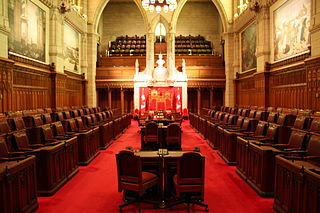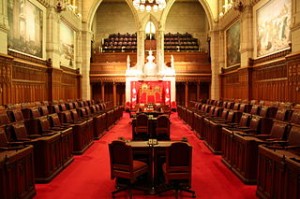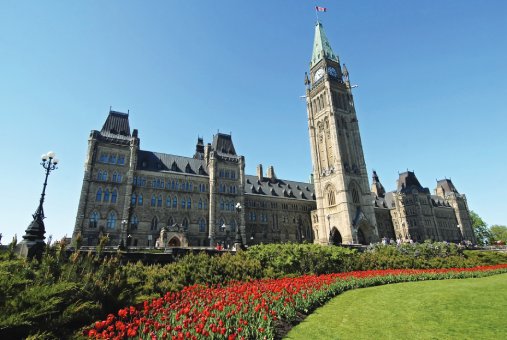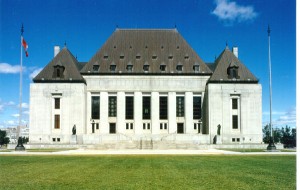 You’ll recall that, a few posts back in this series, we noted that the role of a Senator was intended to be quite different than the role of a Minister of Parliament (MP). That is still the case today.
You’ll recall that, a few posts back in this series, we noted that the role of a Senator was intended to be quite different than the role of a Minister of Parliament (MP). That is still the case today.
The key starting point – MPs handle, in part, the “government” part of the country: remember MPs have constituents to represent, and Cabinet Ministers are the heads of federal departments and MPs in opposition work as shadow “critics” to the these departments. But the two houses do share a similar role – although they carry out their parts very differently (and in a way that relates back to the goals involved in the establishment of the Senate in the first place). That role: making laws (“legislation”).
How is federal legislation made?
Canadian federal legislation must pass through both houses before an idea for a law actually becomes a “law”. When it is first introduced, it is called a “bill”. If you are old enough, you may recall that video in the Schoolhouse Rock series during Saturday morning cartoons – “I’m only a bill” (American, but similar concept).
There are two types of bills:
- public bills, which deal with public policy (like the budget bill); and
- private members’ bills, which convey special rights or powers on a particular individual or a specific group. A recent example is discussed here.
Most bills considered by Parliament are public bills. While bills can be introduced either in the Senate (in which case their bill number starts with letter S) or in the House of Commons (in which case their bill number starts with the letter C), the majority of public bills in Parliament come from the House of Commons. In addition, the Senate cannot introduce money bills, meaning bills that collect or spend public funds.
All bills must be considered and passed by both the Senate and the House of Commons before receiving Royal Assent from the Governor General (the final step in a bill’s passage into law).
There are five steps involved in each house. They are as follows:
- First reading
The house receives the bill, and it is circulated. This is an introductory proceeding and takes place without debate or vote. - Second reading
MPs / Senators debate the principles of the bill. To help with this process, the bill may be referred to a committee for closer examination before voting. - Committee stage
A committee study the bill clause by clause. It may also do research and hear evidence. During, or a result of this process, members of the committee may propose changes to the bill (known as amendments).After it has completed the clause-by-clause analysis, the committee adopts a report on the bill. The report will recommend either: that the bill be accepted as is, that it be accepted with amendments, or that it be rejected. Committees often also append observations to their report. These comments may highlight issues raised by the committee’s study of the bill. - Report stage
If the committee’s report recommends adopting the bill as is (i.e., with no amendments), there is no report stage and the bill goes directly to third reading. If, however, the report suggests amendments to the bill, members must debate the report and either accept, amend, or reject the amendments, in whole or in part. - Third reading
This is the final stage of debate. Members may propose further amendments at this stage before voting to pass or reject the bill.
Once a bill has been approved in both houses, it is ready for Royal Assent.
If both houses go through a similar process, how are their roles different?
Despite the similarities in the bill-reviewing process in the 2 houses, as the Senate cannot introduce money bills, and since most bills contain at least some financial provisions, most the proposed legislation studied by Senate originates in the House of Commons. As a result, most of the bills introduced in the Senate are private members bills.
That said, legislation actually being proposed by the government of the day can also originate in the Senate. There a few reasons for that. For example:
- It is cost-effective. Petitioners for private bills must pay all legal, printing and translation costs, and the minimum fee in the House of Commons is over twice that of the fee in the Senate.
- Starting in the Senate can speed up the process, as the House of Commons might be quite mired in other things at that point in time.
- The Senate excels at one of the most time-consuming parts of making laws – committee work. No law is made in a vacuum: it is the result of many things, including public will, changes in society and scientific progress. And it takes a lot of time and effort to study and document all of those factors. MPs have constituents to directly represent (which is why they all have local offices and spend so much time in their communities) and a public service to be responsible for [neither of which Senators do]: there simply would not be enough time to do research and inquiries that are completed in the Senate. In addition, Senators, since they cannot be voted out in the next election, tend to have longer terms of office (an average of 11 years, as opposed to the MP average of 6), thus helping with consistency in the time it takes to study issues.
As stated by retired Queen’s University professor Ned Franks:
That’s what the Senate does best, is study.[…] Committees there tend to be less partisan than the House of Commons. The members tend to have more experience and they have more time. They’re immune largely from pressures of party politics. So they often do really good jobs of looking at programs and issues.[1]
Similarly, Jack Stilborn, a researcher at the Library of Parliament noted in 2008:
Policy studies are conducted by standing committees in both houses, but those of the Senate sometimes involve more extensive deliberations, enable members to acquire more specialized knowledge, and address broader issues. This effectiveness has been attributed to greater continuity in the membership of Senate committees, the relative freedom of Senate committee work from partisan political pressures, and the absence of time-consuming electoral duties, which enables some Senators to invest more time in this work.[2]
These differences are not surprising when one recalls the original role envisioned for Senators including the fact they are to be appointed: “for the purpose of obtaining […] advice and assistance in all weighty and arduous affairs which may be the State and Defence of Canada concern”.
Does the Senate have many committees?
Yes, and several different kinds. These committees range from 5 to 15 Senators and require a quorum of four members. Quorum is the minimum number of senators needed to constitute a meeting. The rules for the various kinds of committees are in the Rules of the Senate.
A first kind of committee is Standing Committee. Standing Committees exist for the duration of a session of Parliament, continuing throughout periods of prorogation and dissolution of Parliament (as permitted by the Parliament of Canada Act). In addition to the Committee of Selection, there are currently sixteen standing Senate committees. They are:
- Aboriginal Peoples
- Agriculture and Forestry
- Banking, Trade and Commerce
- Conflict of Interest for Senators
- Energy, the Environment and Natural Resources
- Fisheries and Oceans
- Foreign Affairs and International Trade
- Human Rights
- Internal Economy, Budgets and Administration
- Legal and Constitutional Affairs
- National Finance
- National Security and Defence
- Official Languages
- Rules, Procedures and the Rights of Parliament
- Social Affairs, Science and Technology
- Transport and Communications
A second kind of committee is the Special Committee. These committees are established to study either a specific piece of legislation or to undertake a study on a particular issue. The motion establishes a special committee usually sets out the parameters of the committee’s study, from which it cannot deviate without permission from the chamber. It will commonly name the members of the committee and the date by which the committee must report, and it will sometimes include other provisions such as the power to travel and to contract professional services. A well-known recent example of such a committee is the Special Committee on the Canadian Mission in Afghanistan.
A third kind of committee is the Joint Committee. These are made up of both Senators and MPs. They have a proportionate number of members from each house, reflecting their relative sizes. Such committees may be established through the procedural rules of each house (a standing joint committee) or by a motion adopted by each house (a special joint committee). There are two standing joint committees: Scrutiny of Regulations and Library of Parliament. Sometimes, there can be a joint special committee. For example: in 1997 Senator Landon Pearson formed a Special Joint Committee on Child Custody and Access. The Committee spent 12 months studying issues surrounding divorce, child custody, child support and parental access to children. Its members heard from Canadians in every region and completed their report, For the Sake of the Children, in December 1998.
For more information on Senate committees, see the Senate committees webpage.
Does committee work only happen between 2nd and 3rd reading in the Senate?
No. Committee work can be completed in relation to bills before they even come to the Senate (through pre-study committee reports). Committees also conduct longer-term studies on topics in their area of interest. Recent examples of this kind of committee work include the special studies about: hydro-carbon transportation, cyber-bullying, a national energy strategy, and mental health. However, the committee work regarding current bills always takes precedence over other kinds of committee work.
Do committees deal only with paperwork?
No. In order to help Senators understand the legislation and its potential impact, committees often call witnesses to public hearings. This helps to ensure that both experts are consulted and those who will be most impacted by any changes are heard.
If the Senate cannot introduce money bills, does that mean that it cannot suggest changes to money bills either?
No. As was stated in the Report of the Special Committee Appointed to Determine the Rights of the Senate in Matters of Financial Legislation:[3] “…the Senate of Canada has and always had since it was created, the power to amend Bills originating in the Commons appropriating any part of the revenue or imposing a tax by reducing the amount therein, but has not the right to increase the same without consent of the Crown.”
Can the Senate reject a bill that has already passed in the House of Commons?
Yes. Both houses can pass, amend, delay or defeat bills. Senators do not usually delay or defeat legislation already passed by MPs, but they can reject bills and they will.
For example: if the Senate decides the government of the day does not have a mandate to do what it proposes, or a bill is not good legislation because it is misguided, based on wrong information or not in the public interest, it will bring the legislative process to a halt. If this occurs, the government must generally begin the process all over again.
Does the Senate often reject government bills?
No. Since 1945, the Senate has only defeated 6 government bills. They include: Bill C-43 on abortion, Bill C-28 on the Lester B. Pearson International Airport in Toronto, and Bill C-220 on profiting from authorship with respect to a crime. The Senate has, however, a larger record of defeating private member’s bills.
For more information on the topic of today’s post, see:
- Coulombe, Françoise. The Value of the Bicameral Legislature: The Contribution of the Canadian Senate. Library of Parliament Research Paper, revised, February 1979.
‘Marilyn Doyle’; ‘Vincent Chu’

 As you have probably heard, yesterday the Prime Minister announced that he will be asking the Governor General to prorogue Parliament until October (the original return date of Parliament was September 16th).
As you have probably heard, yesterday the Prime Minister announced that he will be asking the Governor General to prorogue Parliament until October (the original return date of Parliament was September 16th). In school, we learn that the Supreme Court of Canada (SCC) is the ‘highest court’ in the land (and has been since 1949). We learn that lower court decisions can be “appealed” to the SCC, and we hear about all kinds of important decisions coming from the Court. But, for most of us, the exact process of getting to the SCC, and whether that is even possible, is a bit of mystery. Add to that the influence from television crime shows, which seem to imply that anything and everything can and should be appealed …. and it is no surprise that most of us a little fuzzy on the issue of appeals.
In school, we learn that the Supreme Court of Canada (SCC) is the ‘highest court’ in the land (and has been since 1949). We learn that lower court decisions can be “appealed” to the SCC, and we hear about all kinds of important decisions coming from the Court. But, for most of us, the exact process of getting to the SCC, and whether that is even possible, is a bit of mystery. Add to that the influence from television crime shows, which seem to imply that anything and everything can and should be appealed …. and it is no surprise that most of us a little fuzzy on the issue of appeals. A few weeks ago, we wrote a
A few weeks ago, we wrote a